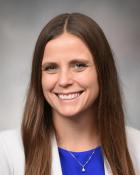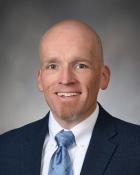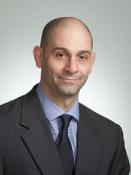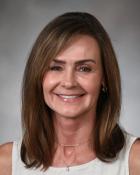A ventricular septal defect (VSD) is a hole between the heart’s lower chambers or ventricles. Typically, the wall between the right and left ventricles closes as babies develop in the womb or within the first few years of life. Once sealed, blood flows in one direction. Through the right side of the heart, oxygen-poor blood flows to the lungs. From the left side of the heart, oxygen-rich blood flows to the rest of the body.
When the ventricular septum — the partition between the chambers of the heart — does not close all the way, the resulting VSD makes blood flow less efficient. This allows oxygen-poor blood and oxygen-rich blood to mix. This congenital heart defect has the potential to make the heart work harder and may result in lung congestion, lower blood oxygenation levels or higher blood pressure. The increased pressure and volume of blood flowing from the right side of the heart can permanently damage blood vessels in the lungs.
Patients born with a ventricular septal defect need ongoing care as adults. The experts at the Adult Congenital Heart Program at UK Gill Heart & Vascular Institute have the experience and expertise needed to provide the lifelong monitoring these patients need.
Symptoms of a ventricular septal defect depend on the size of the VSD and may not appear for several weeks after the baby is born. An infant with a small VSD may not have any symptoms, and the hole may eventually close on its own. Large VSDs may cause a detectable heart murmur and other symptoms, including:
- Fatigue while feeding
- Poor weight gain
- Rapid breathing and/or difficulty breathing
- Shortness of breath
- Sweating
In adults, high blood pressure in the lungs can develop as a result of an untreated larger VSD. This is due to the heart and lungs having to work harder because of excess blood pumped into the lungs. Over time, this can damage the blood vessels in the lungs, and the heart’s increased blood flow can potentially cause heart failure.
The larger the ventricular septal defect, the more likely treatment will be recommended. There is no approved medicine to speed up or cause ventricular septal defects to close. Small VSDs have the potential to close without treatment. Large VSDs may require surgery to address.
Because the oldest patients who had VSD closure surgery as children are now in their 60s, long-term statistics about expected lifespan are not yet available. However, if the surgery was performed before problems developed in the heart and lungs, the prognosis is excellent, and the patient’s lifespan is expected to be normal.
VSDs are the most common congenital heart defect, but for most children the cause is unknown. For some, a VSD is just one of the congenital heart defects present.
Although rare, adults can develop ventricular septal defects after a heart attack. Also, small VSDs present since childhood become symptomatic when people reach adulthood.
Children with congenital heart disease become adults with congenital heart disease (CHD). Ninety percent of children born with CHD have a normal life expectancy due to improved surgical interventions and better medical management. At all ages, close monitoring and expert care for CHD patients are essential. Despite this, studies indicate that 2 out of 3 young adults with CHD don’t transition from pediatric to adult CHD care. Not getting continued cardiac care can lead to a variety of health problems and poor outcomes.
To guide teens and their families through the transition, UK Gill Heart & Vascular Institute team members talk about the transition early and often. Starting at age 15, teens with CHD begin transition education. One Wednesday every month, a special transition clinic staffed by adult congenital heart disease providers, is held to meet with teens and their families to discuss important topics, including:
- Abilities and limitations experienced as an adult with CHD
- Lifelong need for proper CHD monitoring and treatment
- What adult CHD care may involve over the years
Additionally, once you transition to adult care with the Adult Congenital Heart Program at UK Gill Heart & Vascular Institute, we work hard to enable you to keep your appointments and testing on track. We also work hard to empower you with knowledge and assist you in being your best advocate to live your best life. If you miss an appointment, we will call to reschedule.
During your first visit to the UK Gill Heart & Vascular Institute’s Adult Congenital Heart Program, you’ll meet our clinic nurse, social worker and other members of your care team. You’ll also undergo imaging exams, which may include an echocardiogram or a cardiac MRI.
Once imaging is complete, you will meet with an adult congenital cardiologist and other team members for up to one hour. You’ll discuss the results of your echocardiogram and your health history and symptoms. You will also get in-depth education about your diagnosis, how it may affect you moving forward and possible treatment options. The meeting is also a great opportunity to ask any questions about living with CHD.
When coming to your appointment:
- Bring a list of any medications or supplements you take and surgeries you’ve undergone.
- Dress comfortably.
- Have your insurance information on hand. UK HealthCare accepts most insurers, and financial assistance is available.
- You may want a family member or friend with you to take notes or help ask questions.
Where we are located
The UK Gill Heart & Vascular Institute is located at 800 Rose St. in Pavilion G, on the first floor of UK Albert B. Chandler Hospital. We will mail you a map and directions when your appointment is scheduled.
Patient drop-off
Patients can be dropped off in front of the main entrance to Albert B. Chandler Hospital at 1000 S. Limestone. If you are dropped off at the main entrance, you’ll enter the revolving doors on the ground floor of the hospital. Take the main stairs just to the left (or elevator across the atrium) to the first floor of Pavilion A.
After climbing the stairs or taking the elevator, turn left. You’ll pass the Kentucky Wall and Kentucky Children’s Hospital on your right. Continue to the end of the hall until it comes to a T shape. Turn left and the Gill clinic entrance is across from an open area housing the organ donor wall.
Parking
It is easiest to park in the UK HealthCare Parking Garage, across from the hospital at 110 Transcript Ave.
There are two paths from this garage to the Gill clinic:
- You may take the free shuttle from Level A of the parking garage. You’ll exit the shuttle at the Pavilion A/ Pavilion G stop in front of the main entrance to the hospital. After climbing the stairs or taking the elevator, turn left. You’ll pass the Kentucky Wall and Kentucky Children’s Hospital on your right. Continue to the end of the hall until it comes to a T shape. Turn left and the Gill clinic entrance is across from an open area housing the organ donor wall.
- From Level C of the parking garage you may walk or take a golf cart across the pedway to the first floor of Pavilion A. Turn left past the help desk and walk away from the dining hall. You’ll pass the Kentucky Wall and Kentucky Children’s Hospital on your right. Continue to the end of the hall until it comes to a T shape. Turn left and the Gill clinic entrance is across from an open area housing the organ donor wall.
If you need help finding your way, information desks are located inside the main entrances to Pavilion A, both on the ground floor and at the end of the pedway on the first floor. You may also call the information desk at 859-323-5816.
Clinical trials provide access to novel treatments for those in the adult CHD program at UK Gill Heart & Vascular Institute. Through our Cardiology Clinical Research Center, patients benefit from advances in valve replacement and other therapies before they become standard treatment. Your care team will notify you if you qualify for an ongoing clinical trial.








